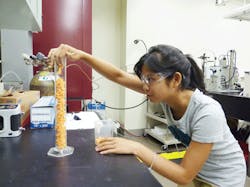Is clumping density standard, regardless of size?
Scientists at the National Institute of Science and Technology (NIST) studied soot, a suspected culprit in global warming, assuming it would consist of carbon nanoparticles clumped together with an overall density of about 0.74. That figure is the maximum packing density of perfect spheres, and researchers thought the tiny soot particles would act as spheres. They were surprised to find the density, when actually measured, turned out to be 0.36.
To find out why the value differed from the expected 0.74, the research team asked two summer interns to model clumping using 6-mm plastic spheres. They glued together clumps of 1 to 12 of the pellets used as ammo by pellet guns in thousands of random combinations and shapes. Then they repeatedly filled a range of cylindrical and spherical containers and measured the actual density. They plotted density versus clump size, and it formed a curve that leveled off at 0.36. Coincidence?
Researchers checked various sources and found similar findings. For example, NASA had density data on 20 comets, which are aggregates of clumps of dust and ice. NASA estimated the packing density to be between 0.2 and 0.4, which means if more comets were studied the density could average 0.36. This figure is also close to the density values for compacted silicon dioxide monomers, which are used in the ceramic industry, and for pharmaceutical powders made from microscale random aggregates. So 0.36 might be the normal packing density for any aggregate of rigid particles regardless of size. NIST will continue to explore the issue.

